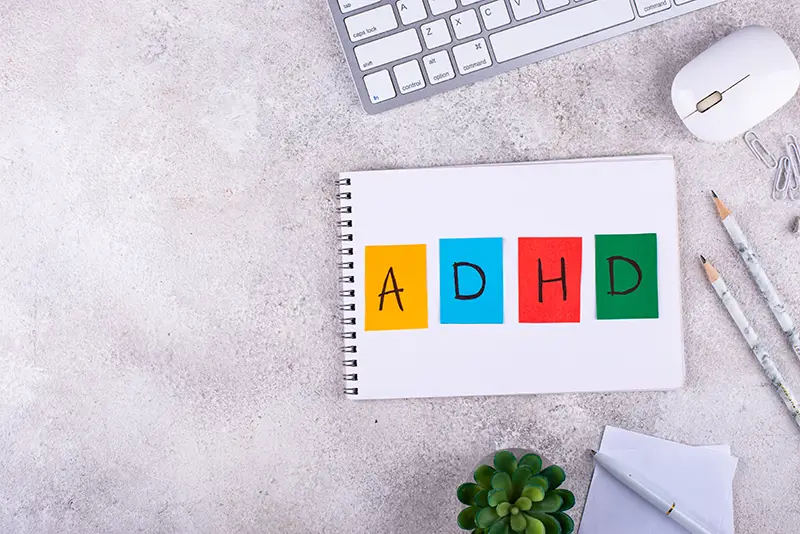Physicians treating pediatric patients often encounter neurodevelopmental disorders, with attention deficit hyperactivity disorder (ADHD) being one of the most common. Accurately assigning the correct diagnosis code for ADHD, including cases categorized as ADD without hyperactivity, is more complex than simply following the ICD-10 Alphabetic Index. Partnering with a reliable medical billing and coding company can ensure accurate code assignment, effective documentation, and clear communication of ADHD diagnoses.
Struggling with ADHD billing and coding?
For expert support to simplify your claim submission and maximize reimbursement.
ADHD Diagnosis
According to the CDC, approximately 7 million U.S. children aged 3–17 years (11.4%) were diagnosed with ADHD in a 2022 national parent survey. ADHD symptoms can range from mild to severe, with about 6 in 10 children experiencing moderate or severe symptoms. Children with ADHD who also have co-occurring conditions, such as behavioral or conduct problems, learning disorders, anxiety, or depression, are more likely to have severe ADHD compared to those without additional conditions. In about 50% of people with childhood ADHD, the condition continues into adulthood.
Although ADHD is not classified as a learning disability, it can significantly impact a child’s ability to learn. The main symptoms of the disorder are inattention, hyperactivity, and impulsivity. ADHD is categorized into three subtypes:
- Hyperactive/impulsive: The patient does not show significant inattention.
- Inattentive type: The patient does not show significant hyperactive-impulsive behavior.
- Combined type: The patient displays both inattentive and hyperactive-impulsive symptoms.
ADHD is sometimes accompanied by other disorders such as Tourette’s syndrome, oppositional defiant disorder, conduct disorder, anxiety, depression and bipolar disorder.
ICD-10 Codes for ADHD
ADHD is coded based on a behavior type. The ADHD ICD-10 codes are:
- F90.0: Attention deficit hyperactivity disorder, predominantly inattentive type
- F90.1: Attention deficit hyperactivity disorder, predominantly hyperactive type
- F90.2: Attention deficit hyperactivity disorder, combined type
- F90.8: Attention deficit hyperactivity disorder, other type
- F90.9: Attention deficit hyperactivity disorder, unspecified type
The F90 category includes:
- Attention deficit disorder with hyperactivity
- Attention deficit syndrome with hyperactivity
Billing F90.0
F90.0 is a billable/specific ICD-10 code used to denote “Attention-Deficit Hyperactivity Disorder, predominantly inattentive type, without the significant hyperactive or impulsive behaviors that characterize other types.” Symptoms include significant difficulties in maintaining focus on tasks or play activities, following through on instructions, and managing sequential tasks.
ICD-10 lists the following conditions as special exclusions (Excludes2) to ADHD:
- Anxiety disorders (F40.-, F41.-)
- Mood (affective disorders) (F30-F39)
- Pervasive developmental disorders (F84.-)
- Schizophrenia (F20.-)
It may not be possible to confirm an ADHD diagnosis during the first office visit. It often takes two or more visits to either confirm or rule it out. According to ICD-10 guidelines for outpatient coding, if the condition is documented as “rule out,” “working diagnosis,” or using similar terms, it shows uncertainty and a diagnosis code should NOT be assigned. In this case, the correct approach is to report codes for the symptoms or signs observed during the visit.
A patient with ADHD may have other conditions that are not reflected in the ADHD ICD-10 codes. If the diagnosis includes any of the conditions listed in the type 2 exclusion note, both codes can be assigned as needed to provide a full picture of the patient’s condition.
Tips for ADHD Medical Billing
- Code to the greatest level of specificity:
- Only code F90.9 if you are unable to determine a more specific ADHD diagnosis.
- Use F90.0 (Attention-deficit hyperactivity disorder, predominantly inattentive type) to code ADD, the first type of ADHD.
- Do not use codes F90.8 (Attention-deficit hyperactivity disorder, other type) or F90.9 (Attention-deficit hyperactivity disorder, unspecified type) to document ADD, as both specifically mention hyperactivity in their descriptors.
- F90.2 (the combined type) can be used if the patient exhibits significant symptoms of hyperactivity or impulsivity.
- Follow exclusion notes: ICD-10-CM often lists conditions in either an Excludes1 or Excludes2 note. It is important that all exclusion notes be followed carefully for coding accuracy. For example, the Excludes2 code Excludes2: attention-deficit hyperactivity disorder (ADHD) due to known physiological condition explains that ADHD should not be coded when it is caused by a known physiological condition.
- Code to support the diagnosis: Make sure code assignment aligns precisely with the diagnosis provided.
- Ensure adequate documentation: Document the symptoms that justifies the use of the specific code.
Documentation Requirements
A qualified professional must conduct ADHD evaluations, requiring training in differential diagnosis and psychiatric disorders. Psychologists, neuropsychologists, psychiatrists, and physicians with relevant training are generally considered qualified to evaluate and diagnose ADHD.
Documentation for an ADHD diagnosis should include evidence of both early and current impairment. Current impairment can be established through a detailed diagnostic interview and a comprehensive review of sources, including the history of presenting symptoms, developmental and family history of ADHD, relevant medical and medication history, and prior therapy records.
Per American Academy of Pediatrics (AAP) guidelines, ADHD diagnosis in children requires documented difficulties in multiple settings, such as school and home. For adults, a clinical diagnosis requires six or more symptoms persisting for at least six months at a maladaptive level inconsistent with development. Additional criteria include:
- Symptoms must have caused problems before the age of 7.
- The behavior is abnormal for a non-ADHD child of the same age.
- Symptoms of hyperactivity/impulsivity which were present in childhood, and the current symptoms which have been present for at least the past six months and which impair functioning in two or more settings (e.g. school, work, and home) must also be identified.
- A history of individual presenting attentional symptoms and evidence of current impulsive/hyperactive or inattentive behaviors.
ICD-11 ADHD Changes
ICD-11 significantly updates the classification of ADHD by formally including it as a separate diagnostic category for the first time. It has 11 inattention and 11 hyperactivity/impulsivity symptoms, marking an expansion from the previous edition. Additionally, the ICD-11 distinguishes symptoms based on age, and includes distinct criteria for younger children compared to adolescents and adults. ICD-11 also has a new hyperactivity/impulsivity symptom addressing impulsive decision-making and risk-taking behaviors.
Billing and coding for attention deficit hyperactivity disorder can be complex due to several factors, including the variability in diagnostic criteria, treatment options, and payer requirements. Relying on expert medical billing and coding services can ensure compliance and minimize claim denials while ensuring appropriate reimbursement for ADHD-related care.
Ensure accuracy and compliance in ADHD billing and coding!




